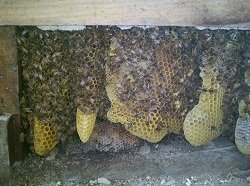Honey Bee Removal with a Cut Out
Honey bee removal doing a cut out can be tricky.
It requires work setting up your equipment for the bee nest removal, for removing the covering materials in such a way that they can be replaced correctly, and for removing bees and comb when you find location of the comb.
Generally, the honey bee removal process can take from 5 hours for one man up to 8 hours for 2 men.
It all depends on how where the beehive is located in the building, how long it takes you to get to it, and the actual time to do the honey bee removal once you get to the comb.
Steps of the Process
Observe the location of the beehive entrance
- Bee activity around the entrance should be very regular. Hot days may produce “bearding” which happens when bees gather outside the entrance to cool off.
- Determine where a cavity approximately 45 liters [12 gallons] in volume could be located within 8 to 10 inches of the entrance:
 |
|
Setup necessary equipment for the cut out process
|
 |
- Dismantle material covering the hive to expose the wax comb for removal
- Use your Bee Vacuum to begin the honey bee removal and then cut out the comb [Bees tend to get in the way when you are removing their comb].
- Remove the bees from the comb with the bee vacuum. [Be sure to set your suction to just pull bees off the comb. You don’t want dying bees as they bang into the back of your bee vacuum!]
- Cut the comb out of hollow space where the bees have been building [thus the name “cut out”] as you clear them with the vacuum.
 |
|
- Place the brood comb in empty frames, and put in the super to transport to the new location
- Save the honey comb for later – to feed to the bees or save for yourself
- After all the comb and bees are removed, the entrance and be sealed up and the covering materials replaced.
- Materials required for repair and amount of finish repair desired by the beekeeper should be negotiated before the work begins.
- Finished repair may or may not be included in the Removal Service pricing. This should be discussed before the work begins.
- A few straggler bees may still be around, but they will leave or die in a day or so.
- Put brood comb super on the Bee Vac and join bees in the bee vacuum to the brood comb. This can be done at the job site or when they are at their new home. Click here for more information on our Bee Vac page.
- Take the hive of bees to their new home.
Do you need to get rid of bees at your home or business? Fill out the Contact Us form and we will follow up with you on getting rid of the bees.
List your favorite or find a new one to try!


If you see bees going in and out of a structure, you may be in for a surprise as to what is behind the wall.